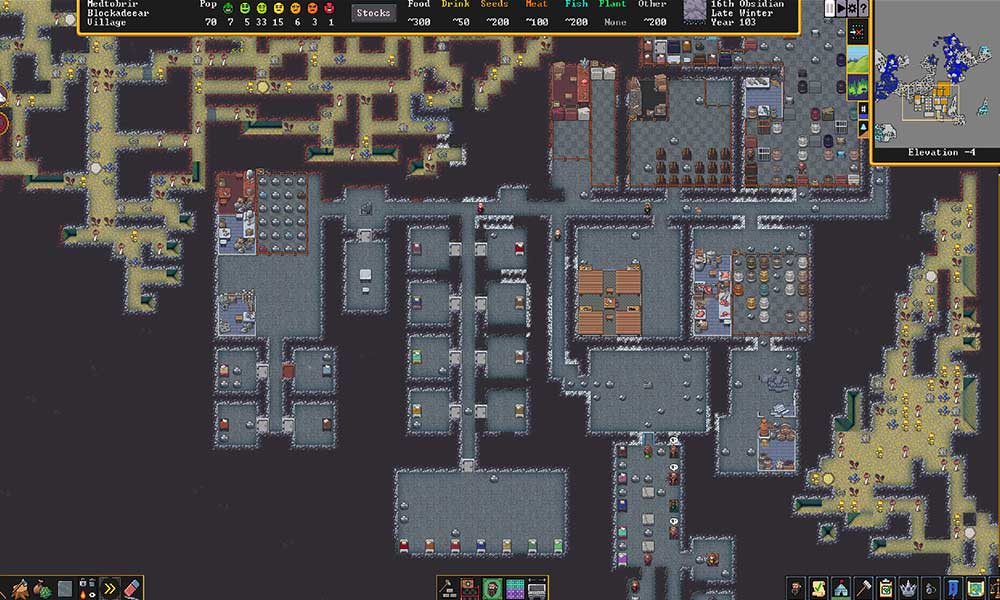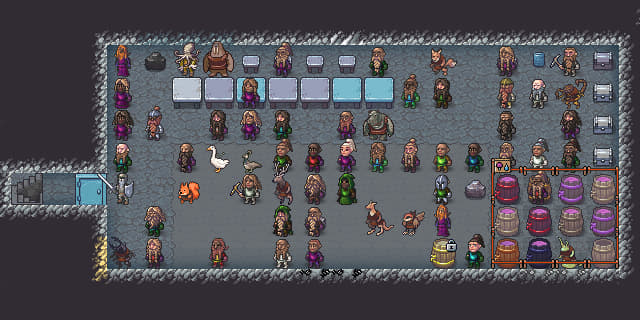Everyone is talking about the all-new Dwarf Fortress game. The game has been developed by Bay 12 Games and published by Kitfox Games. The Dwarf Fortress game is very unique to play. You will need to work on building a fortress to help your dwarves survive there.
For surviving in any world, one of the important things is food. You can get food only through farming. If you have to feed your people in the game, then the only way by which you can do it is by Farming. We know it is not a simple process. You will need to have a lot of knowledge about the lands, crops, how to plant, how to harvest, etc. so that you can farm properly in the game.
To help you in farming in the Dwarf Fortress, we are here with a guide. With the help of this guide, you will get to know about the right way of farming in Dwarf Fortress. Keep on reading this guide till the end to know more about it.
Also Read

Page Contents
How To Build a Farm in Dwarf Fortress
For building a farm in Dwarf Fortress, you will need to get the proper soil. We have listed them, make sure to check them.
Topsoil
- Loamy sand
- Peat
- Loam
- Sandy loam
- Sandy clay loam
- Silty clay loam
- Silt
- Silt loam
Ocean Floor
- Siliceous ooze
- Calcareous ooze
- Pelagic clay
Sand
- Sand
- White sand
- Black sand
- Yellow sand
- Red sand
Clay
- Clay loam
- Clay
- Fire clay
- Silty clay
- Sandy clay
How To Plant Crops in Dwarf Fortress

Once you have built the farm, then you will need to choose the right crop for each season in the game. However, there are many plants that you can grow. All the crops that are available in the game have different things in common.
- The crops grow every season.
- It can be grown from seeds.
Here are some crops that you should know about when planting on the farm.
Ground Crops
- White millet: Any Temperate
- Two-grain wheat: Tropical Grassland, Tropical Savanna
- Teff: Tropical Grassland
- Spelt: Any Temperate
- Sorghum: Tropical Grassland, Tropical Savanna
- Soft wheat: Tropical Grassland, Tropical Savanna
- Single-grain wheat: Tropical Grassland, Tropical Savanna
- Rye: Any biome not freezing
- Rice: Any tropical
- Red spinach: Any biome not freezing
- Ramie: Any tropical
- Quinoa: Any Temperate
- Purple amaranth: Any Temperate
- Pendant amaranth: Any tropical
- Pearl millet: Any tropical
- Papyrus sedge: Any Tropical Wetland
- Oats: Any Temperate
- Maize: Any tropical
- Kenaf: Any tropical
- Kaniwa: Any Temperate
- Jute: Any tropical
- Hemp: Any Temperate
- Hard wheat: Tropical Grassland, Tropical Savanna
- Foxtail millet: Any Temperate
- Fonio: Tropical Savanna
- Flax: Tropical Grassland, Tropical Savanna
- Finger millet: Any Temperate
- Elephant-head amaranth: Any tropical
- Cotton: Any tropical
- Buckwheat: Tropical Dry Broadleaf Forest
- Blood amaranth: Any tropical
- Bitter vetch: Any Temperate
- Barley: Any biome not freezing
- Alfalfa: Any biome not freezing
Garden Plants
- Winter melon: Any Tropical
- Wild Carrot: Any Temperate
- White yam: Any Tropical
- Watermelon: Any Tropical
- Urad bean: Any Tropical
- Turnip: Any Temperate
- Taro: Any Tropical
- Sweet potato: Any Tropical
- String Bean: Any Temperate
- Squash: Any Tropical
- Spinach: Any Temperate
- Soybean: Any Temperate
- Rhubarb: Any Temperate
- Red Bean: Any Temperate
- Raspberry: Any Temperate
- Radish: Any Temperate
- Purple yam: Any Tropical
- Potato: Any biome not freezing
- Pineapple: Any Tropical
- Pepper: Any Tropical
- Pea: Any Temperate
- Passion fruit: Any Tropical
- Parsnip: Any Temperate
- Onion: Any Temperate
- Mung bean: Any Tropical
- Long yam: Any Temperate
- Lesser yam: Any Tropical
- Lentil: Any biome not freezing
- Leek: Any Temperate
- Horned melon: Any Tropical
- Grape: Any Temperate
- Garlic: Any Temperate
- Garden cress: Any Temperate
- Cranberry: Any Temperate, Tundra, Taiga
- Cowpea: Tropical Grassland
- Chicory: Any Temperate
- Chickpea: Any Tropical
- Celery: Any Temperate
- Cassava: Any Tropical
- Caper: Any Desert, Any Grassland
- Cabbage: Any Temperate
- Broad Bean: Any Temperate
- Blueberry: Any Temperate, Tundra, Taiga
- Blackberry: Any Temperate
- Bitter melon: Any Tropical
- Bilberry: Any Temperate, Tundra, Taiga
- Beet: Temperate Grassland
- Asparagus: Any Temperate
- Artichoke: Temperate Grassland
Subterranean Plants
- Sweet pod: Subterranean Water
- Quarry bush: Subterranean Water
- Plump helmet: Subterranean Water
- Pig tail: Subterranean Water
- Dimple cup: Subterranean Water
- Cave wheat: Subterranean Water
Other Plants
- Whip wine: Any biome not freezing
- Valley herb: Temperate grassland
- Sun berry: Any biome not freezing
- Strawberry: Any biome not freezing
- Silver barb: Any biome not freezing
- Rope reed: Any biome not freezing
- Rat weed: Any biome not freezing
- Prickle berry: Any biome not freezing
- Muck root: Any Wetland
- Longland grass: Any biome not freezing
- Hide root: Any biome not freezing
- Fisher berry: Any biome not freezing
- Bloated tuber: Any Wetland
- Blade weed: Any biome not freezing
How To Do Farming in Dwarf Fortress
For farming in Dwarf Fortress, you will need to follow some procedures. We have listed them out, so make sure to check them.
- Checking The Land
Once you are going to do farming, the first thing that you will need to do is to prepare and check the land. When you start digging the land, then you will find different types of soil. You will need to check the quality of the soil. After it, go to the labour menu to select the planter.
- Start The Plantation
When you have checked the land, then you can start the plantation. You will need to select the correct plant for bowing into the land. There are different seasons for which you will need to select different plants that can grow. Along with it, there are some seeds that grow multi-seasonal. You will have to check them so that you can plan your seeds accordingly to it.
When you go to the farmland, then select the seed according to your current season. Once you do this, make sure to check this for other seasons too, so that you can keep on growing regularly.
- Fertilize The Plants
After planting the seeds, you can use the fertilizer so that you can grow them fast. It is produced through two steps procedure. First, you will need to make ash by burning wood. After making it, you can fertilize the land. Also, there is an option by which you can regularly keep the fertilizer “on” so that your land can be fertilized by the planters.
- Harvest The Plants
After fertilization, your plants and crop are ready to harvest. Thus, the planters will harvest the crops on their own, once the plant is ready to harvest. It will be an automatic process, so you will not need to worry about it. The planters will harvest the crop and will arrange it according to the types of crops that have been grown.
Wrapping Up
Dwarf Fortress is a very interesting game that the players are loving much. Farming is one of the methods which is involved in the game to feed the survivor. You will need to know every essential information before farming. We have provided you with all the required information so that you can grow proper crops on your farmland. We hope that this guide has helped you. That’s all for this guide. In case, if you have any doubts, then do let us know in the comment section below.
